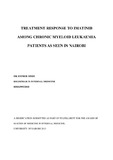| dc.description.abstract | Background: Imatinib (Glivec/Gleevec) therapy has improved outcomes in chronic myeloid leukaemia (CML) in the last 10 years. It is an expensive drug. In Kenya, over 250 patients with CML access the medication via GIPAP (Glivec International Assistance Programme), at no cost. Their response to imatinib was unknown. This study was carried out to determine patients‟ hematologic response to imatinib, proportion of patients with failure and the possible predictors of failure.
Methods: This was a cross-sectional descriptive study carried out at the Nairobi Hospital GIPAP clinic. Subjects studied were Philadelphia chromosome positive (Ph+ve) CML patients who had been on imatinib therapy for at least 3 months. The investigator reviewed patients and perused through their records, extracting social-demographic, clinical and laboratory data. Characteristics of patients with hematologic failure were recorded and compared with those of patients with good response.
Treatment failure was defined as lack of complete hematologic response after 3 months of imatinib treatment or relapse after initial response.
Results: A total of 206 patients were studied, 194 of whom were in chronic phase. Median period of clinic follow up was 26 months. Prevalence of hematologic failure was 20.9 %( 95% CI: 15.5-26.7). The mean duration of illness was 27.5 months, mean duration on imatinib was 25.5 months, and mean duration to start of imatinib was 1 month. Heterogeneity was noted in following variables; the failing group had higher; BCR-ABL concentration (mean of 81% vs. 68.2%), non-adherence (60.5% vs. 37.4%), longer durations between diagnosis and start of imatinib treatment, prior therapy, prolonged illness as well as exposure to imatinib itself, these differences were all significant with p values<0.008. Prolonged
xiv
duration between diagnosis and start of imatinib was an independent predictor of failure, OR 2.69(1.03-7.03 95%CI), p-value 0.043. Kaplan Meier estimator of time in CHR; showed Mean Survival time of 67 months (95% CI: 59.3-74.7).
Conclusion: This study demonstrated that majority [163 (79.1%)] of the patients had sustained CHR. A fifth of the 43 patients with failure had primary failure. Prolonged duration between diagnosis and start of imatinib was an independent predictor of failure | en |

